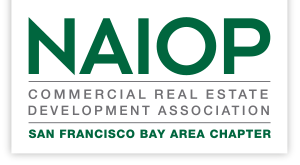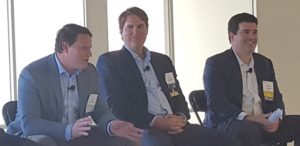The Chapter held its annual Deal Makers event on Thursday June 22nd at 100 First Street in San Francisco. Jason Chadorchi, Managing Principal, Align Real Estate moderated a candid (and often irreverent!) discussion. It featured an encore performance from three of the Bay Area’s top capital markets advisors who happen to be good friends and entertaining sparing partners:
- Mark Penrod, Managing Director, Eastdil Secured
- Rob Hielscher, Managing Director, JLL Capital Markets Group
- Steve Golubchik, Vice Chairman, Commercial Capital Markets, Newmark Cornish & Carey
Chadorchi posed thought-provoking questions to the panel revealing their perspectives on:
- Bay Area Sub-markets
- Transaction Volume
- Leasing
- Technology and trends
- Advice for young professionals
East Bay
Given his significant activity in the market, with Oakland City Center and Mount Diablo Plaza Chadorchi asked Golubchik to go first. Golubchik shared his belief that the East Bay is starting to come into its own having reshaped itself over the last few years and is now a core market.
Golubchik’s key observations included:
- More value add capital is willing to go to the East Bay
- Deals over $100 million getting a thinner bid pool
- Sweet spot is $50 to $80 million with strong interest from trade capital, Asian capital and a considerable amount of institutional capital
- Everyone is looking for downside protection
- Easier to underwrite assets in the East Bay because it is a bit safer investment strategy
- not banking on the back end value appreciation
- getting north of 5% in place cap rates
- below market rents
- sub $400 – $500 per sf basis
Chadorchi then asked Golubchik to compare the Walnut Creek and Oakland sub-markets
Golubchik’s insights on the markets included:
Walnut Creek
- Walnut Creek Bart Transit Village deal was a game changer
- Investors are starting to see it as more of an urban-suburban market
- More lift in reversion values
- The market is underpriced on a relative basis, but has been one of the hottest markets in 2017 with the deepest bid pools we’ve seen since 20-15 – 12-15 offers usually
Oakland
- More aggressive rents and better retention rates
- Many tenants want to be in Oakland for specific reasons
- Groups get more aggressive on thinner in place yields and compressing on stabilized cap rates
- Less of a focus on reversion values
Hielscher concurred with Golubchik regarding Oakland and Walnut Creek being the hottest sub-markets. He added some perceptive on the other parts of the East Bay:
Emeryville
- Selling a value add creative office redevelopment deal
- Pioneering value – stabilized bases of over $400 psf
- Incredibly deep buyer interest
- Rents justifying it, the concern is the exit value
Tri Valley
- Have been waiting collectively for core plus capital to migrate to those markets
- Continues to feel like have and have not
- Everybody is chasing the in-fill and transit adjacent markets
- Occupier side strong in the Tri Valley but the capital is yet to get out there outside of the big opportunity funds
- Activity and pricing are both likely to improve in the next 12-18 months
Peninsula / South Bay
Chadori called on Penrod to start this discussion given the Beacon/Menlo campus he is marketing in Santa Clara.
Penrod said that on the new development side Silicon Valley has an interesting dynamic. Many of the developers that are active in the market are probably not going to be viewed as active traders.
He added:
- The market recognized that most of the develops will not trade in the next 5 – 15 years
- Paying up for the newer product fundamentally different than the older product makes sense
- There are headwinds in Santa Clara
- Core investors in particular are making a clear delineation
- Cap rates in the valley are higher than in SF
Golubchik, who is selling the Brocade HQ on Highway 237, agreed with Penrod and commented:
- There is a bit of a herd mentality
- Everyone sees vacancy and thinks the market is turning
- It is a high beta market
- There are opportunities for those that understand flight to quality, best in class product
- People are beating up rents and beating up stabilization time-frames the bid/ask cap is wide on the value deals
- The spread between the Valley and the City for stabilized deals is over 100-150 basis points, abnormally wide
Chadorchi then asked who is making up the buyer pool in the South Bay?
Golubchik responded:
- Aside from Google they’re not seeing that many active users
- The contrarian players
Hielscher also commented that he is seeing:
- Increased interest from unusual capital – international high net worth or trade buyers
- Investors who have migrated to SV because of lack of opportunities in SF and priced out of SF
San Francisco
Hielscher reported he thinks a major challenge in San Francisco is lack of deal supply. There are a number of deals that have traded to long term holders are fewer deals in the hands of short-term holders. Ten years ago most of the groups buying in SF were commonly selling in three to five years. He commented on the McKesson Headquarters at One Post, which he recently sold, and indicated that it is a good example of the demand for value-add deals and the mentality where vacancy is worth as much or more than leased space. The extremely deep buyer interest in One Post illustrates the lack of value add opportunities in San Francisco.
Hielscher also commented:
- 100 Pine (which was more of a core-plus deal) had a thinner buyer pool than McKesson
- Thinks buyer underwriting in the last 12 months has been pretty conservative
- Predicted that pricing on the next quality office deals that come out for sale in the City will surprise people on the upside
- Believes that in stronger suburban Bay Area submarkets it is not a matter of yield, it’s more of an issue with basis
- Tougher to get deals done with a WALT of 4-6 years. Ideal profile is either buildings with near term vacancy or roll that buyers can get to quickly or deals with long-term (10+ years) leases.
Penrod agreed with Hielscher that the underlying leasing fundamentals seem to be wildly more optimistic than you would then convert to underwriting.
His key comments included:
- In addition to there being a great deal of value add capital, there will be increased ability to drive NOI in the next 12 to 24 months
- Pacific Place deal (core all the way) saw the bid sheets continue to evolve
- The last two years have definitely been the years of the foreign investor
- Has seen the reemergence of the domestic capital source as being a viable candidate for core transactions last 3-6 months
- Domestic core funds picky about what assets they buy, however prepared to pay core pricing for core deals
Golubchik weighed in indicating that he believes that in general San Francisco over next 5 to 10 years is a winner providing stability and downside protection.
He said:
- Housing and transportation issues will remain constant in the Bay Area
- There is more value appreciation on a percentage basis in alternative markets, as Value oriented buyers are attracted to markets that are creating their new downtown nodes along transit like Redwood City and San Mateo, Oakland or Walnut Creek. This is being done to compete with San Francisco
- However, people will always continue to want to live in SF
- More and more companies will continue to move into the City
- San Francisco is a bit of a safer bet for buyers looking for wealth preservation
Transaction Volume
Penrod stated that there appears to be a trend line toward lower transaction volume with the caveat that all things change. He shared these thoughts:
- The last few years SF has been unique compared to other markets with more buyers designed to hold assets longer
- Thinks the panelists jobs will be more difficult because of an increase in tailor made transactions
- More common place to see owner operators and joint ventures require different structures
Hielscher expressed that he is of opinion that what is happening is a fundamental shift in terms of the ownership groups and their investment philosophies. He indicated he thinks the straight fee simple sales in San Francisco will be considerably slower in the near future. He thinks the lack of buildings for sale combined with FIRPTA and Prop 13 will be additional drivers of partial interest sales.
Golbuchik said he thinks the debt markets are impacting the trade volume as well if you look outside of San Francisco.
He pointed to what is happening in Redwood City as an example:
- The majority of the developers are merchant builders
- The entire market is stabilized and pre-leased
- Product is delivered and developers are going out for fixed rate and stabilized financing
- Debt is cheap and accretive
Leasing
Hielscher said that on the ground there is a lot of optimism on the leasing side and that if all the rumored deals happen he predicts that rents will to spike.
He shared these comments:
- There is one more Class A office tower (Park Tower) delivering after 181 Fremont and then it will be a wait until Oceanwide Center comes on line
- From an acquisitions perspective we are seven years into an up market and people don’t have the stomach to go to their investment committee and predict a rent spike, even if they think it’s going to happen
- Thinks there is a disconnect with people on the ground saying rents will be in the low to mid 80s next year, and acquisitions people who are underwriting no or inflationary rent growth
- This disconnect creates some interesting buying opportunities
Debt
Chadorchi acknowledged that the debt markets have moved a great deal and asked the panelists to comment.
Penrod concurred and called the movement in the last 90 – 120 days breathtaking.
He added:
- Now at back to borrowing rates pre-election
- Debt funds are under pressure
- Floating debt is better than 2006-07 in many ways
- On the fixed rate side it feels like SF is outperforming other markets
- Most bidders on core deals are unlevered buyers
- Predicts it will put pressure on the suburban markets
Golubchik pointed out that he thinks Libor has gone up 6X.
He commented:
- Could create opportunities for tradable assets in the future
- Agrees with Penrod about pressure on suburban markets
- Has seen a slight change in re-pricing in value add deals
- Challenge in the Bay Area is that there is no volume of product for value add deals, so the potentially hit to values is offset by the supply vs. demand fundamental
Technology and trends
First Chadorchi asked what the impact of autonomous vehicles will be on real estate?
Hielscher said:
- CBDs and differentiated, amenitized suburban campuses will be beneficiaries
- Trend toward deals on Cal train and BART will be at risk, since public transit agency will become less critical
Next Chadorchi asked how clients look at WeWork’s credit and if it is a trend that will continue to grow?
Golubchik pointed to 201 Spear and what Amazon did as and example of a large tech companies moving toward the trend of M&A and incubation and wanting flexibility as opposed to shelling out dollars for overhead costs and being confined to long term leases.
He also said:
- There is no gray area with it – you either believe in or not
- Some of the larger REITs and investor have bought into it
- Most are concerned about over allocation within a building
- Indicated that retail developers see it as a driver of foot traffic
Advice for Young Professionals
Penrod expressed that by participating in organizations young professionals get wide exposure to all the different markets, asset types and acquisition strategies. He said:
The more you learn and surround yourself with interesting people the more you will be exposed to new opportunities.
Golubchik pointed out that the market we have been in for the last 7 to 10 years has been abnormal.
He advised:
"Remember that things always do change at some point."
Hielscher recommended finding some way to differentiate yourself to those starting out in their careers.
He shared:
"There are a lot of smart people doing what we do and you need to find a way to stand out."








































